We provide AZ-102 Free Practice Questions which are the best for clearing AZ-102 test, and to get certified by Microsoft Microsoft Azure Administrator Certification Transition. The AZ-102 Free Practice Questions covers all the knowledge points of the real AZ-102 exam. Crack your Microsoft AZ-102 Exam with latest dumps, guaranteed!
Free demo questions for Microsoft AZ-102 Exam Dumps Below:
NEW QUESTION 1
You have an Azure subscription named Subscription1.
You deploy a Linux virtual machine named VM1 to Subscription1. You need to monitor the metrics and the logs of VM1.
What should you use?
- A. LAD 3.0
- B. Azure Analysis Services
- C. the AzurePerformanceDiagnostics extension
- D. Azure HDInsight
Answer: C
Explanation: You can use extensions to configure diagnostics on your VMs to collect additional metric data.
The basic host metrics are available, but to see more granular and VM-specific metrics, you need to install the Azure diagnostics extension on the VM. The Azure diagnostics extension allows additional monitoring and diagnostics data to be retrieved from the VM.
References: https://docs.microsoft.com/en-us/azure/virtual-machines/linux/tutorial-monitoring
NEW QUESTION 2
Which blade should you instruct the finance department auditors to use?
- A. Partner information
- B. Overview
- C. Payment methods
- D. Invoices
Answer: D
Explanation: You can opt in and configure additional recipients to receive your Azure invoice in an email. This feature may not be available for certain subscriptions such as support offers, Enterprise Agreements, or Azure in Open.
Select your subscription from the Subscriptions page. Opt-in for each subscription you own. Click Invoices then Email my invoice.
Click Opt in and accept the terms.
Scenario: During the testing phase, auditors in the finance department must be able to review all Azure costs from the past week.
References: https://docs.microsoft.com/en-us/azure/billing/billing-download-azure-invoice-dailyusage- date
NEW QUESTION 3
Note: This questions is part of a series of questions that present the same scenario. Each questions in the series contains a unique solution that might meet the stated goals. Some questions sets might have more than one correct solution, while others might not have a correct solution. After you answer a questions in this section, you will NOT be able to return to it. As a result, these questions will not appear in the review screen.
You have an Azure virtual machine named VM1. VM1 was deployed by using a custom Azure Resource Manager template named ARM1.json.
You receive a notification that VM1 will be affected by maintenance. You need to move VM1 to a different host immediately.
Solution: From the Update management blade, you click enable. Does this meet the goal?
- A. Yes
- B. No
Answer: B
Explanation: You would need to Redeploy the VM.
References: https://docs.microsoft.com/en-us/azure/virtual-machines/windows/redeploy-to-newnode
NEW QUESTION 4
You have the Azure virtual networks shown in the following table.
To which virtual networks can you establish a peering connection from VNet1?
- A. VNet2 and VNet3 only
- B. VNet2 only
- C. VNet3 and VNet4 only
- D. VNet2, VNet3, and VNet4
Answer: C
Explanation: The virtual networks you peer must have non-overlapping IP address spaces. The VNet1 and VNhet2 address spaces overlap. The range of VNet2 is contained inside the range of VNet1.
References:
https://docs.microsoft.com/en-us/azure/virtual-network/virtual-network-managepeering# requirements-and-constraints
NEW QUESTION 5
Note: This questions is part of a series of questions that present the same scenario. Each questions in the series contains a unique solution that might meet the stated goals. Some questions sets might have more than one correct solution, while others might not have a correct solution. After you answer a questions in this section, you will NOT be able to return to it. As a result, these questions will not appear in the review screen.
Your company registers a domain name of contoso.com.
You create an Azure DNS zone named contoso.com, and then you add an A record to the zone for a host named www that has an IP address of 131.107.1.10.
You discover that Internet hosts are unable to resolve www.contoso.com to the 131.107.1.10 IP address.
You need to resolve the name resolution issue.
Solution: You create a PTR record for www in the contoso.com zone. Does this meet the goal?
- A. Yes
- B. No
Answer: B
Explanation: Modify the Name Server (NS) record.
References: https://docs.microsoft.com/en-us/azure/dns/dns-delegate-domain-azure-dns
NEW QUESTION 6
HOT SPOT
You need to implement App2 to meet the application? To answer, select the appropriate options in the answer area.
NOTE: Each correct selection is worth one point.
Answer:
Explanation: Box 1: Standard
Not Shared: A Shared plan does not support Always on. Box 2: Always on
If your function app is on the Consumption plan, there can be up to a 10-minute delay in processing new blobs if a function app has gone idle. To avoid this cold-start delay, you can switch to an App Service plan with Always On enabled, or use a different trigger type.
Scenario: A newly developed API must be implemented as an Azure function named App2. App2 will use a blob storage trigger. App2 must process new blobs immediately.
App2 must be able to connect directly to the private IP addresses of the Azure virtual machines. App2 will be deployed directly to an Azure virtual network.
The cost of App1 and App2 must be minimized. References:
https://docs.microsoft.com/en-us/azure/azure-functions/functions-bindings-storage-blob https://azure.microsoft.com/en-us/pricing/details/app-service/plans/
Case Study: 13 Mix Questions Set F
NEW QUESTION 7
HOT SPOT
You need to recommend a solution for App1. The solution must meet the technical requirements. What should you include in the recommendation? To answer, select the appropriate options in the answer area.
NOTE: Each correct selection is worth one point.
Answer:
Explanation: This reference architecture shows how to deploy VMs and a virtual network configured for an N-tier application, using SQL Server on Windows for the data tier.
Scenario: You have a public-facing application named App1. App1 is comprised of the following three tiers:
A SQL database A web front end
A processing middle tier
Each tier is comprised of five virtual machines. Users access the web front end by using HTTPS only. Technical requirements include:
Move all the virtual machines for App1 to Azure. Minimize the number of open ports between the App1 tiers.
References: https://docs.microsoft.com/en-us/azure/architecture/reference-architectures/n-tier/n-tier-sql-server
NEW QUESTION 8
You have an Azure DNS zone named adatum.com. You need to delegate a subdomain named research.adatum.com to a different DNS server in Azure. What should you do?
- A. Create an PTR record named research in the adatum.com zone.
- B. Create an NS record named research in the adatum.com zone.
- C. Modify the SOA record of adatum.com.
- D. Create an A record named “.research in the adatum.com zon
Answer: D
Explanation: Configure A records for the domains and sub domains.
References: http://www.stefanjohansson.org/2012/12/how-to-configure-custom-dns-names-formultiple- subdomain-based-azure-web-sites/
NEW QUESTION 9
You are the global administrator for an Azure Active Directory (Azure AD) tenant named adatum.com.
You need to enable two-step verification for Azure users. What should you do?
- A. Configure a playbook in Azure AD conditional access policy.
- B. Create an Azure AD conditional access policy.
- C. Create and configure the Identify Hub.
- D. Install and configure Azure AD Connec
Answer: B
Explanation: References:
https://docs.microsoft.com/en-us/azure/active-directory/authentication/howto-mfa-mfasettings
NEW QUESTION 10
SIMULATION
Click to expand each objective. To connect to the Azure portal, type https://portal.azure.com in the browser address bar.
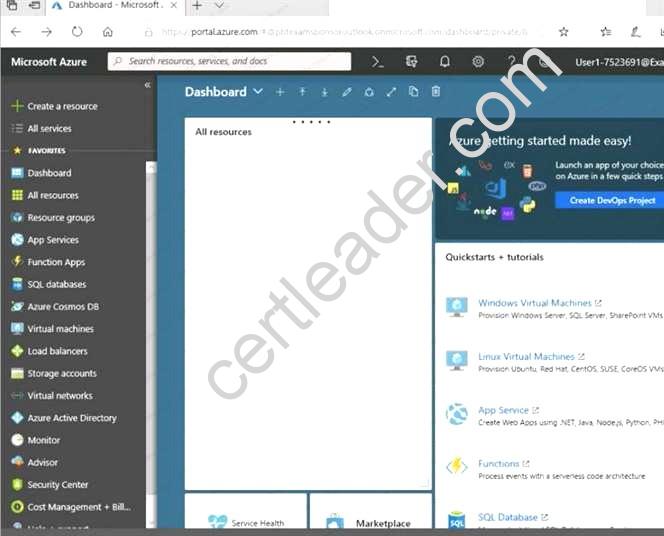
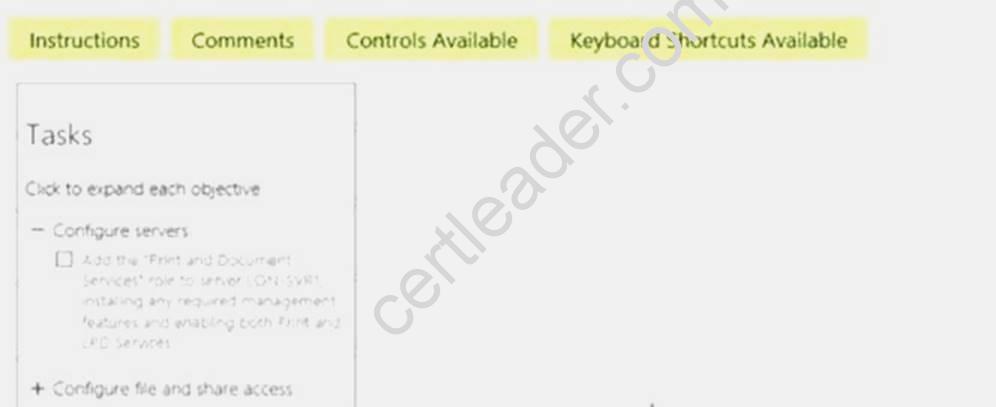
When you are finished performing all the tasks, click the ‘Next’ button.
Note that you cannot return to the lab once you click the ‘Next’ button. Scoring occur in the background while you complete the rest of the exam.
Overview
The following section of the exam is a lab. In this section, you will perform a set of tasks in a live environment. While most functionality will be available to you as it would be in a live environment, some functionality (e.g., copy and paste, ability to navigate to external websites) will not be possible by design. Scoring is based on the outcome of performing the tasks stated in the lab. In other words, it doesn’t matter how you accomplish the task, if you successfully perform it, you will earn credit for that task.
Labs are not timed separately, and this exam may have more than one lab that you must complete. You can use as much time as you would like to complete each lab. But, you should manage your time appropriately to ensure that you are able to complete the lab(s) and all other sections of the exam in the time provided.
Please note that once you submit your work by clicking the Next button within a lab, you will NOT be able to return to the lab.
To start the lab
You may start the lab by clicking the Next button.
You plan to protect on-premises virtual machines and Azure virtual machines by using Azure Backup. You need to prepare the backup infrastructure in Azure. The solution must minimize the cost of storing the backups in Azure.
What should you do from the Azure portal?
Answer:
Explanation: First, create Recovery Services vault.
Step 1: On the left-hand menu, select All services and in the services list, type Recovery Services. As you type, the list of resources filters. When you see Recovery Services vaults in the list, select it to open the Recovery Services vaults menu.
Step 2: In the Recovery Services vaults menu, click Add to open the Recovery Services vault menu.
Step 3: In the Recovery Services vault menu, for example, Type myRecoveryServicesVault in Name.
The current subscription ID appears in Subscription. If you have additional subscriptions, you could choose another subscription for the new vault.
For Resource group select Use existing and choose myResourceGroup. If myResourceGroup doesn't exist, select Create new and type myResourceGroup.
From the Location drop-down menu, choose West Europe. Click Create to create your Recovery Services vault.
References: https://docs.microsoft.com/en-us/azure/backup/tutorial-backup-vm-at-scale
NEW QUESTION 11
Your Azure environment contains an application gateway and custom apps.
Another administrator modifies the application gateway and the apps to use HTTP over TCP port 8080.
Users report that they can no longer connect to the apps.
You suspect that the cause of the issue is a change in the configuration of the application gateway. You need to modify the application gateway to resolve the issue.
What should you do from the Azure portal?
Answer:
Explanation: Step 1:
Select Networking and then select Application Gateway in the Featured list, and select the application gateway, and select the settings.
Step 2:
Click HTTP for the protocol of the listener and make sure that the port is defined as 443.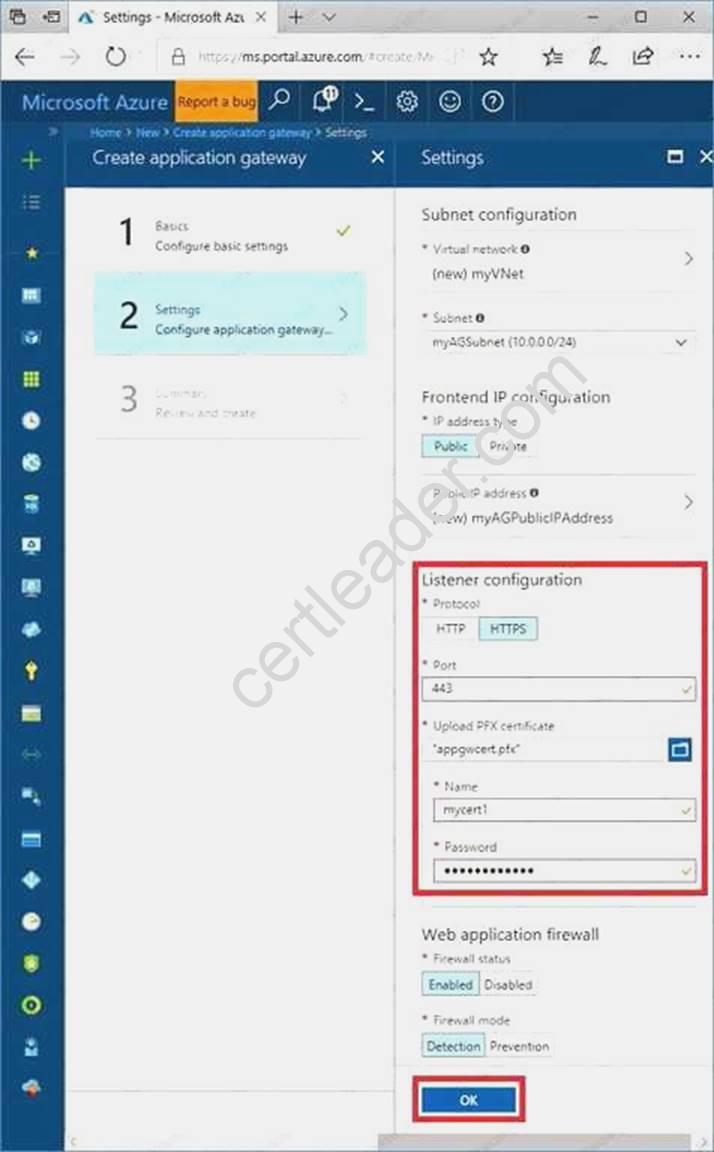
References:
https://docs.microsoft.com/en-us/azure/application-gateway/create-ssl-portal
NEW QUESTION 12
You create a new replication policy in Azure for the physical servers. You successfully complete the following actions:
Create and configure a Recovery Services vault.
Ensure Internet connectivity.
Ensure that the required URLs are reachable.
Ensure that the host server requirements are met.
Ensure that the servers marked for replication comply with the requirements of the Azure virtual machines.
You need to replicate the on-premises servers to Azure.
Which four actions should you perform in sequence? To answer, move the appropriate actions from the list of actions to the answer area and arrange them in the correct order.
NOTE: More than one order of answer choices is correct. You will receive credit for any of the correct orders you select.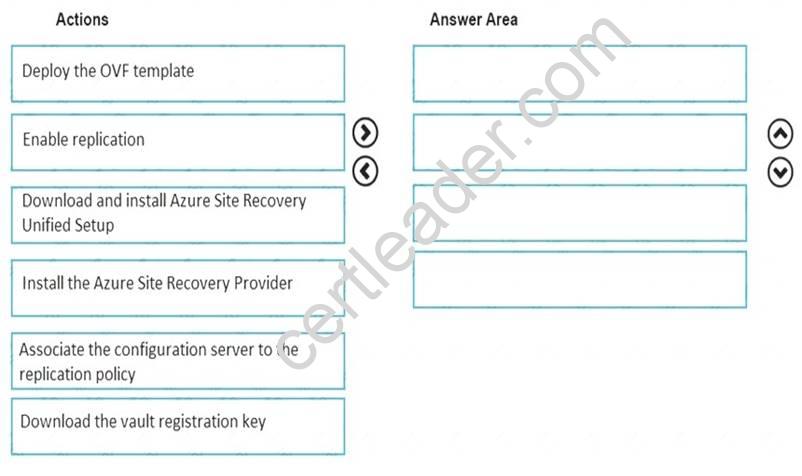
Answer:
Explanation: Step 2: Deploy the OVF template Set up the source environment.
Download the OVF template for the configuration server, and import the template in VMware.
Note: Open Virtualization Format (OVF) template is an industry standard software distribution model for virtual machine templates. Starting January 2021, configuration server for the VMware to Azure scenario will be available to all our customers as an OVF template.
Step 3: Associate the configuration server to the replication policy Associate the replication policy with your on-premises configuration server. Step 4: Enable replication
References:
https://docs.microsoft.com/en-us/azure/site-recovery/vmware-azure-set-up-replication
NEW QUESTION 13
DRAG DROP
You need to prepare the New York office infrastructure for the migration of the on-premises virtual machines to Azure.
Which four actions you perform in sequence? To answer, move the appropriate actions from the list of actions to the answer area and arrange them in the correct order.
Answer:
Explanation: Box 1:
From the Azure portal, download the OVF file.
In the vCenter Server, import the Collector appliance as a virtual machine using the Deploy OVF Template wizard.
In vSphere Client console, click File > Deploy OVF Template.
In the Deploy OVF Template Wizard > Source, specify the location for the .ovf file. Box 2: From VM1, connect to the collector virtual machine
After you've created the Collector virtual machine, connect to it and run the Collector. Box 3: From the ASRV1 blade in the Azure portal, select a protection goal.
Box 4: From VM1, register the configuration server. Register the configuration server in the vault
Scenario: The Azure infrastructure and the on-premises infrastructure and the on-premises infrastructure must be prepared for the migration of the VMware virtual machines to Azure. References:
Migrate Your Virtual Machines to Microsoft Azure, Includes guidance for optional data migration, Proof of Concept guide, September 2021 https://azuremigrate.blob.core.windows.net/publicpreview/Azure%20Migrate%20-
%20Preview%20User%20Guide.pdf
NEW QUESTION 14
SIMULATION
Click to expand each objective. To connect to the Azure portal, type https://portal.azure.com in the browser address bar.


When you are finished performing all the tasks, click the ‘Next’ button.
Note that you cannot return to the lab once you click the ‘Next’ button. Scoring occur in the background while you complete the rest of the exam.
Overview
The following section of the exam is a lab. In this section, you will perform a set of tasks in a live environment. While most functionality will be available to you as it would be in a live environment, some functionality (e.g., copy and paste, ability to navigate to external websites) will not be possible by design.
Scoring is based on the outcome of performing the tasks stated in the lab. In other words, it doesn’t matter how you accomplish the task, if you successfully perform it, you will earn credit for that task. Labs are not timed separately, and this exam may have more than one lab that you must complete. You can use as much time as you would like to complete each lab. But, you should manage your time appropriately to ensure that you are able to complete the lab(s) and all other sections of the exam in the time provided.
Please note that once you submit your work by clicking the Next button within a lab, you will NOT be able to return to the lab.
To start the lab
You may start the lab by clicking the Next button.
You plan to store media files in the rg1lod7523691n1 storage account.
You need to configure the storage account to store the media files. The solution must ensure that only users who have access keys can download the media files and that the files are accessible only over HTTPS.
What should you do from Azure portal?
Answer:
Explanation: We should create an Azure file share.
Step 1: In the Azure portal, select All services. In the list of resources, type Storage Accounts. As you begin typing, the list filters based on your input. Select Storage Accounts.
On the Storage Accounts window that appears.
Step 2: Locate the rg1lod7523691n1 storage account.
Step 3: On the storage account page, in the Services section, select Files.
Step 4: On the menu at the top of the File service page, click + File share. The New file share page drops down.
Step 5: In Name type myshare. Click OK to create the Azure file share.
References: https://docs.microsoft.com/en-us/azure/storage/files/storage-how-to-use-files-portal
NEW QUESTION 15
You need to create a function app named corp7509086nl that supports sticky sessions. The solution must minimize the Azure-related costs of the App Service plan.
What should you do from the Azure portal?
Answer:
Explanation: Step 1:
Select the New button found on the upper left-hand corner of the Azure portal, then select Compute
> Function App. Step 2:
Use the function app settings as listed below. App name: corp7509086n1
Hosting plan: Azure App Service plan (need this for the sticky sessions)
Pricing tier of the the App Service plan: Shared compute: Free Step 3:
Select Create to provision and deploy the function app. References:
https://docs.microsoft.com/en-us/azure/azure-functions/functions-create-function-app-portal
NEW QUESTION 16
You need to add a deployment slot named staging to an Azure web app named corplod@lab.LabInstance.Idn4. The solution must meet the following requirements:
When new code is deployed to staging, the code must be swapped automatically to the production slot. Azure-related costs must be minimized.
What should you do from the Azure portal?
Answer:
Explanation: Step 1:
Locate and open the corplod@lab.LabInstance.Idn4 web app.
1. In the Azure portal, on the left navigation panel, click Azure Active Directory.
2. In the Azure Active Directory blade, click Enterprise applications. Step 2:
Open your app's resource blade and Choose the Deployment slots option, then click Add Slot.
Step 3:
In the Add a slot blade, give the slot a name, and select whether to clone app configuration from another existing deployment slot. Click the check mark to continue.
The first time you add a slot, you only have two choices: clone configuration from the default slot in production or not at all.
References:
https://docs.microsoft.com/en-us/azure/app-service/web-sites-staged-publishing
NEW QUESTION 17
SIMULATION
Click to expand each objective. To connect to the Azure portal, type https://portal.azure.com in the browser address bar.





When you are finished performing all the tasks, click the ‘Next’ button.
Note that you cannot return to the lab once you click the ‘Next’ button. Scoring occur in the background while you complete the rest of the exam.
Overview
The following section of the exam is a lab. In this section, you will perform a set of tasks in a live environment. While most functionality will be available to you as it would be in a live environment, some functionality (e.g., copy and paste, ability to navigate to external websites) will not be possible by design. Scoring is based on the outcome of performing the tasks stated in the lab. In other words, it doesn’t matter how you accomplish the task, if you successfully perform it, you will earn credit for that task.
Labs are not timed separately, and this exam may have more than one lab that you must complete. You can use as much time as you would like to complete each lab. But, you should manage your time appropriately to ensure that you are able to complete the lab(s) and all other sections of the exam in the time provided.
Please note that once you submit your work by clicking the Next button within a lab, you will NOT be able to return to the lab.
To start the lab
You may start the lab by clicking the Next button.
You plan to migrate a large amount of corporate data to Azure Storage and to back up files stored on old hardware to Azure Storage.
You need to create a storage account named corpdata7523690n1 in the corpdatalog7523690 resource group. The solution must meet the following requirements:
Corpdata7523690n1 must be able to host the virtual disk files for Azure virtual machines. The cost of accessing the files must be minimized.
Replication costs must be minimized. What should you do from the Azure portal?
Answer:
Explanation: Step 1: In the Azure portal, click All services. In the list of resources, type Storage Accounts. As you begin typing, the list filters based on your input. Select Storage Accounts.
Step 2: On the Storage Accounts window that appears, choose Add. Step 3: Select the subscription in which to create the storage account. Step 4: Under the Resource group field, select corpdatalog7523690.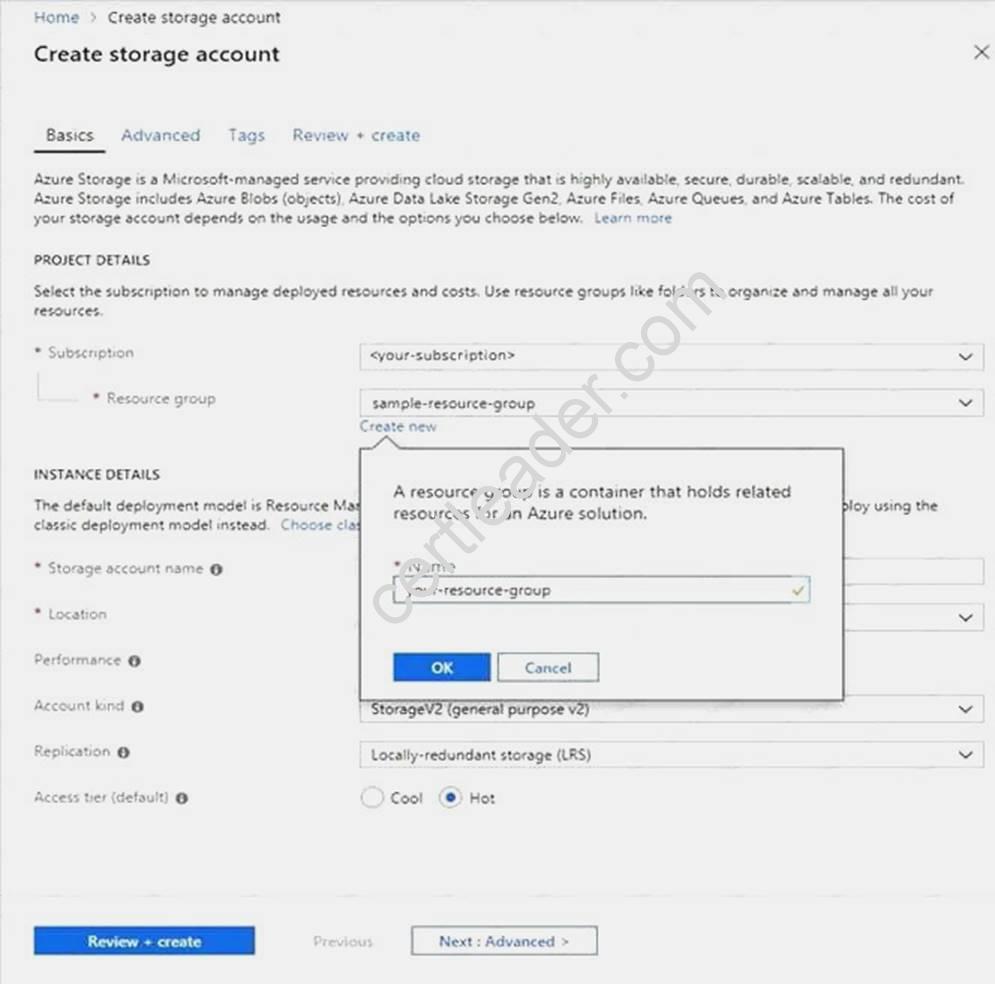
Step 5: Enter a name for your storage account: corpdata7523690n1
Step 6: For Account kind select: General-purpose v2 accounts (recommended for most scenarios) General-purpose v2 accounts is recommended for most scenarios. . General-purpose v2 accounts deliver the lowest per-gigabyte capacity prices for Azure Storage, as well as industry-competitive transaction prices.
Step 7: For replication select: Read-access geo-redundant storage (RA-GRS)
Read-access geo-redundant storage (RA-GRS) maximizes availability for your storage account. RA-GRS provides read-only access to the data in the secondary location, in addition to geo-replication across
two regions. References:
https://docs.microsoft.com/en-us/azure/storage/common/storage-quickstart-create-account https://docs.microsoft.com/en-us/azure/storage/common/storage-account-overview
Recommend!! Get the Full AZ-102 dumps in VCE and PDF From Certleader, Welcome to Download: https://www.certleader.com/AZ-102-dumps.html (New 195 Q&As Version)
